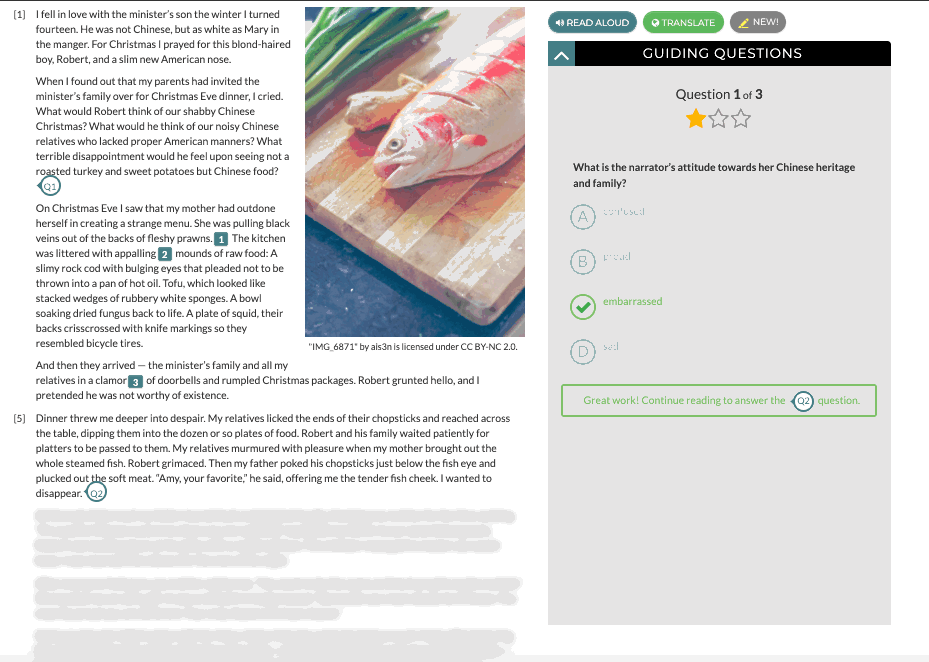The best tool for reading comprehension
As a right-brained English teacher, I did not jump for joy when it came to grading and analyzing data. Although I knew that data-driven instruction was really valuable, spending hours grading and analyzing student performance trends was not my ideal use of a Sunday. However, timely and effective feedback is important for keeping students engaged and motivated.

This is exactly why the assignment report feature on CommonLit is invaluable. It makes it really easy to analyze student performance with a quick turnaround, especially because all of our multiple-choice questions are graded instantly. Instead of spending hours poring over student data just to find the trends yourself, our assignment reports allow you to view trends immediately so that you can identify informed next steps and plan for differentiated instruction.
Let’s take a closer look at how you can leverage Guided Reading Mode data to inform your instruction. We’ll start by looking at the data for a class of students who just read Ralph Fletcher’s “Funeral.”
Ralph, our protagonist, is moving away from home, so his friends have a “funeral” for him to say their goodbyes. The “funeral” is quite touching, and the boys reflect upon the great times that they have spent together. As the story ends, Ralph realizes how much he appreciates his friends, but simultaneously, he learns that he is ready to move on with his life.
Students who struggle with this text typically misinterpret the story as a literal funeral instead of a symbolic gesture. They may also think that Ralph’s friends are having a “funeral” because they’re mad at him or dislike him because he’s moving.
Looking at this data, there are three different areas I would address. The majority of my students made two or more attempts at answering question number 3, a handful of students made two or more attempts at answering question number 2, and two of my students — Jennifer and Sebastian — struggled with the whole text. Let’s take a closer look at how to handle each of these situations:
One-on-One Reading Conferences
First, I want to start by thinking about the two students who really struggled with the whole text. They are struggling with the guided questions or the text complexity, so they need a swift intervention.
If I’m lucky, I can leverage a resource like a co-teacher or after-school time to meet with these students. Otherwise, I would run reading conferences with Jennifer and Sebastian while the rest of the class does another activity, like independent reading.
After rereading the guiding questions, I would likely hypothesize which skill I could teach them at the beginning of the reteach. This will provide a foundation that they can practice and add onto throughout the lesson. I would also come to this conference prepared with scaffolding questions for each Guiding Question by asking myself: If they don’t get THIS, then what could I ask them?
Once Jennifer and Sebastian grasp the figurative nature of the “funeral” in the story, they will be able to read the text with an increased understanding. Depending on their ability level, they may need additional support with vocabulary, identifying main ideas, and finding key details.
Small Group Reteach
The next data point I notice is the four students who had a breakdown in understanding on guiding question #2: Brian, Eric, Gabriela, and Keesha. (Since Jennifer and Sebastian had more severe misunderstandings I chose to provide a more individualized level of support for them).
Working with a small group can easily be accomplished during the beginning or end of class while the remainder of the students complete a warm-up or reflection activity. I would take this section of the text and run a close-reading.
I notice that with this particular question the group needs to really read carefully because the question asks students which answer does “NOT” apply. Now I can help students who either misread the question or did not understand the nature of the “funeral” his friends hosted for him.
Running a Whole Group Reteach
Question #3 was clearly a difficult one for most of my students. By hovering over the question I can take a closer look at where my students got confused.
This is a tough question because the text does not explicitly tell the reader how Ralph feels, and students will have to look very closely at the text to draw this inference. In the text, the character was able to move on because his friends got to say a proper good-bye.
I would run a close-reading of the most relevant paragraphs:
As we read through this section, students will identify key terms and look closely for evidence of Ralph’s emotions. It may help to use the process of elimination. For example, I would help students break down the sentence “Usually I hated it… but this time it felt different” to drive home the idea that he does not feel angry about his move (eliminating option C from the question).
Final Thoughts
Use the three examples above to guide you through addressing data from Guided Reading Mode with your students.
Get into the habit of giving immediate feedback from the guided reading data and your students will quickly start rereading and close-reading texts on their own.
If you are interested in learning more about CommonLit's different digital tools to help you in your classroom, join us at one of our webinars!


